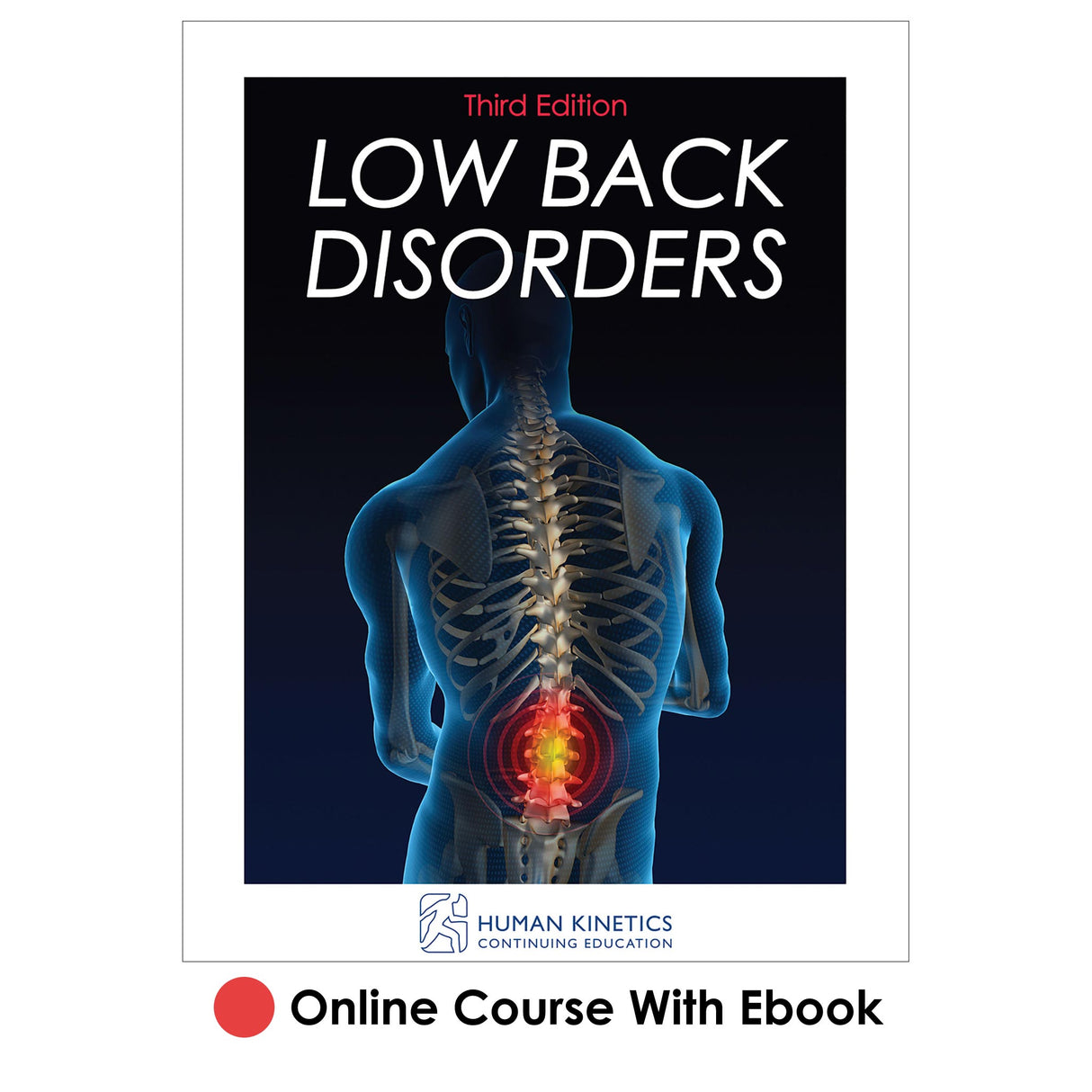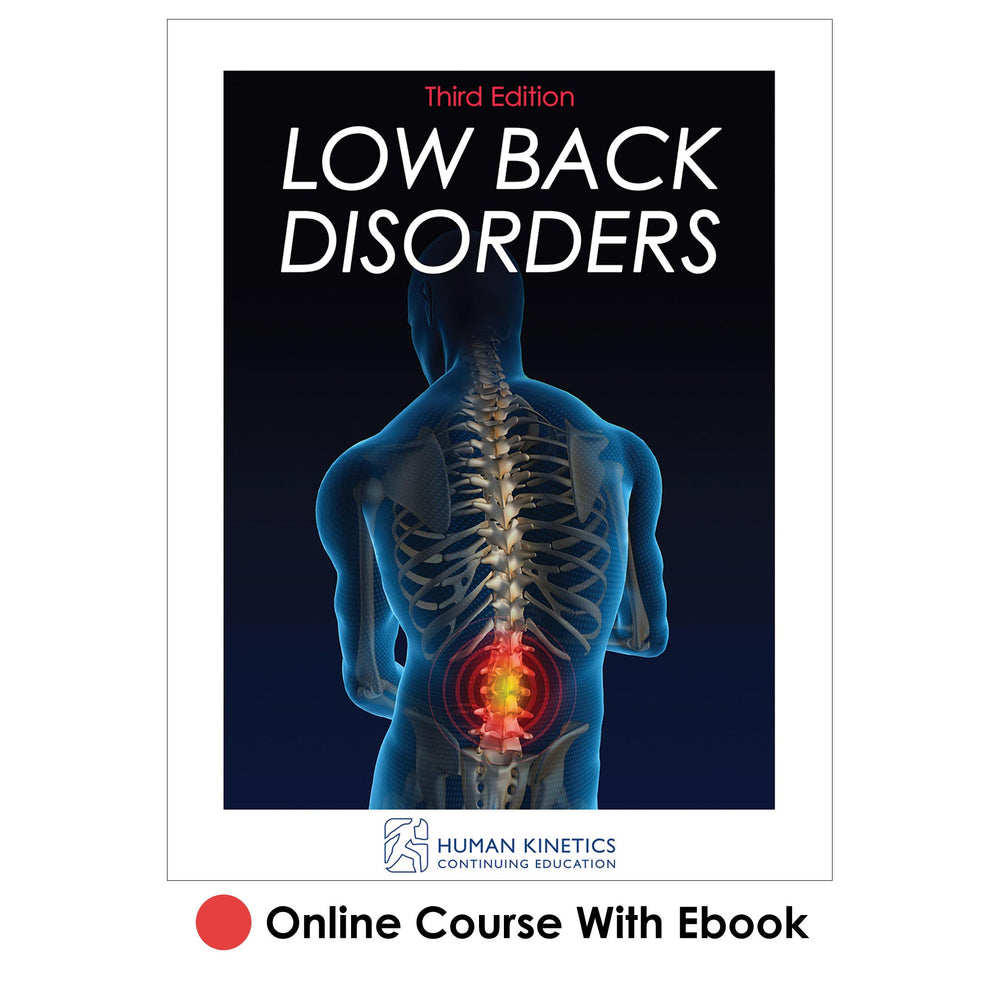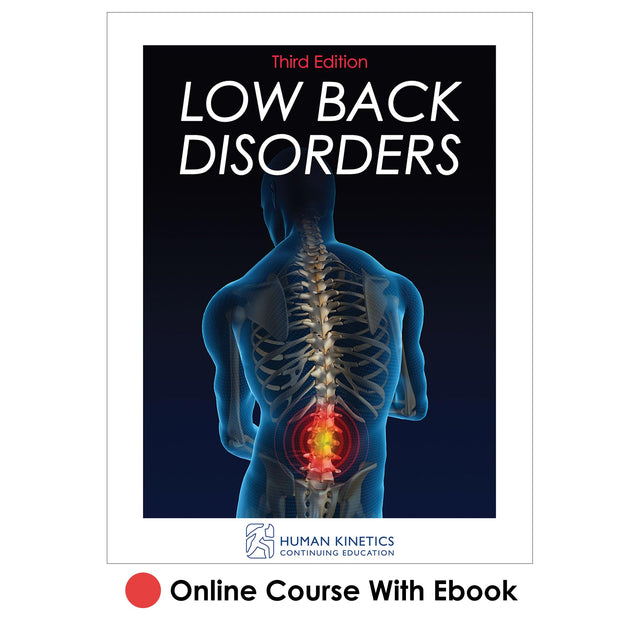Low Back Disorders 3rd Edition Online CE Course With Ebook
Evidence-Based Prevention and Rehabilitation
Author: Human Kinetics
$138.00 USD
Unit price
/
Unavailable
Online Course With Ebook
$138.00 USD
$138.00 USD
This package includes the following:
Based on the third edition of Low Back Disorders by internationally recognized low back specialist Stuart McGill, this course presents the research and applications of back anatomy and biomechanics to build effective prevention and rehabilitation programs. Strong foundational information on anatomy and injury mechanisms guides learners through the essential functions of the structures of the low back and related tissues, and common misconceptions about pain and discomfort are addressed and corrected. The course provides detailed insights into performing injury assessment with an extensive set of tests and accompanying instructions, plus exercises and guidance for developing individualized rehabilitation strategies. In addition to offering strategies for relieving and potentially eliminating pain, it provides insight into the conditions and environments that may initially cause back pain and makes recommendations on reducing these influences so that clients can be pain free.
This ebook features more than 500 photos, graphs, and charts on anatomy, biomechanics, and assessments. Supplementing the practical checklists and step-by-step instructions for 50 tests and exercises are online video clips showcasing various exercises and assessments in action. The study guide offers a course syllabus, chapter objectives, and end-of-chapter learning activities.
Once you complete the course and pass the exam, you can print a certificate for continuing education credits.
Learning Objectives
After completing this course, you will be able to do the following:
- Low Back Disorders: Evidence-Based Prevention and Rehabilitation, Third Edition, ebook
- Online video clips
- Online study guide
- Online continuing education exam
Based on the third edition of Low Back Disorders by internationally recognized low back specialist Stuart McGill, this course presents the research and applications of back anatomy and biomechanics to build effective prevention and rehabilitation programs. Strong foundational information on anatomy and injury mechanisms guides learners through the essential functions of the structures of the low back and related tissues, and common misconceptions about pain and discomfort are addressed and corrected. The course provides detailed insights into performing injury assessment with an extensive set of tests and accompanying instructions, plus exercises and guidance for developing individualized rehabilitation strategies. In addition to offering strategies for relieving and potentially eliminating pain, it provides insight into the conditions and environments that may initially cause back pain and makes recommendations on reducing these influences so that clients can be pain free.
This ebook features more than 500 photos, graphs, and charts on anatomy, biomechanics, and assessments. Supplementing the practical checklists and step-by-step instructions for 50 tests and exercises are online video clips showcasing various exercises and assessments in action. The study guide offers a course syllabus, chapter objectives, and end-of-chapter learning activities.
Once you complete the course and pass the exam, you can print a certificate for continuing education credits.
Learning Objectives
After completing this course, you will be able to do the following:
- Discuss some of the debatable issues regarding low back pain and its treatment.
- Explain the risk factors associated with low back disorders.
- Understand the normal and injury mechanics of the lumbar spine.
- Identify important functional anatomy of the lumbar spine and its relation to injury mechanics.
- Educate clients in prevention strategies to reduce the risk of low back injury.
- Understand the importance of scientifically based decision making in the evaluation and treatment of low back disorders.
- Develop an exercise program that includes safe lumbar stabilization exercises and be able to modify and progress the exercises.
Audience
A continuing education course for physical and occupational therapists, sport and orthopedic physicians, rehabilitation specialists, athletic trainers, and fitness professionals.
Part I. Scientific Foundation
Chapter 1. Introduction to the Issues and Scientific Approach Unique to This Book
Legislative Landscape: The Unfortunate Adverse Impact on Painful Backs
Deficiencies in Current Diagnostic Practices
Inadequacies in Current Care and Prevention
Mechanical Loading and the Process of Injury: A Low Back Tissue Injury Primer
Excellent Clinicians and Excellent Practice
Unique Scientific Foundation of This Book
In Vitro Lab
In Vivo Lab
A Final Note
Chapter 2. Epidemiological Studies and What They Really Mean
Influence of Randomized Controlled Trials and Other Epidemiological Approaches
Misunderstandings of Epidemiology
Multidimensional Links Among Biomechanical, Psychosocial, and Personal Variables
Are Biomechanical Variables and Psychosocial Variables Distinct?
How Do Biomechanical Factors Affect LBD?
Links Between Personal Factors and LBD
Studies of Exercise Intervention
Practical Application: What the Evidence Supports
What Works Clinically
A Final Note
Chapter 3. Functional Anatomy of the Lumbar Spine
Anatomy Trains
Basic Neural Structure
Vascular Anatomy
Vertebrae
Sacroiliac Joints
Intervertebral Disc
Muscles
Ligaments
Lumbodorsal Fascia (LDF)
Quick Review of the Pelvis, Hips, and Related Musculature
Clinically Relevant Aspects of Pain and Anatomic Structure
A Final Note
Chapter 4. Normal and Injury Mechanics of the Lumbar Spine
Kinematic Properties of the Thoracolumbar Spine
Kinetics and Normal Lumbar Spine Mechanics
Dubious Lifting Mechanisms
Other Important Mechanisms of Normal Spine Mechanics
Injury Mechanisms
Biomechanical and Physiological Changes Following Injury
A Final Note
Chapter 5. Myths and Realities of Lumbar Spine Stability
Why Spine Stability Is Important for Everyone
Stability: A Qualitative Analogy
Quantitative Foundation of Stability
Stability Myths, Facts, and Clinical Implications
A Final Note
Part II. Injury Prevention
Chapter 6. LBD Risk Assessment
Brief Review of the Risk Factors for LBD
NIOSH Approach to Risk Assessment
Snook Psychophysical Approach
Lumbar Motion Monitor (LMM)
Ergowatch
Biological Signal–Driven Model Approaches
A Final Note
Chapter 7. Reducing the Risk of Low Back Injury
Lessons From the Literature
LBD Prevention for Workers
The Question of Back Belts
LBD Prevention for Employers
Injury Prevention Primer
A Note for Consultants
Reducing the Risk in Athletes
A Final Note
Part III. Low Back Rehabilitation
Chapter 8. Building Better Rehabilitation Programs for Low Back Injuries
Pain-Reducing Mechanisms of Exercise
Five-Stage Back Training Program
Finding the Best Approach
Stages of Patient Progression
Guidelines for Developing the Best Exercise Regimen
A Final Note
Chapter 9. Evaluating the Patient
Most Crucial Element in Evaluation
First Clinician–Patient Meeting
Assessing Posture and Movement Quality
Some Provocation Tests
Some Functional Screens
Testing Muscle Endurance
A Final Note
Chapter 10. Developing the Exercise Program
Philosophy of Low Back Exercise Design
Clinical Wisdom
Thoughts on Mobility
Identifying Safe and Effective Exercises
Beginner’s Program for Pain Control and Stabilization
Exercises That May Be Used in a Stabilization Program
Special Conditions
A Final Note
Chapter 11. Advanced Exercises
Safely Increasing Challenges
Occupational and Athletic Work Hardening
A Final Note
Epilogue
Handouts for Patients or Clients
Chapter 1. Introduction to the Issues and Scientific Approach Unique to This Book
Legislative Landscape: The Unfortunate Adverse Impact on Painful Backs
Deficiencies in Current Diagnostic Practices
Inadequacies in Current Care and Prevention
Mechanical Loading and the Process of Injury: A Low Back Tissue Injury Primer
Excellent Clinicians and Excellent Practice
Unique Scientific Foundation of This Book
In Vitro Lab
In Vivo Lab
A Final Note
Chapter 2. Epidemiological Studies and What They Really Mean
Influence of Randomized Controlled Trials and Other Epidemiological Approaches
Misunderstandings of Epidemiology
Multidimensional Links Among Biomechanical, Psychosocial, and Personal Variables
Are Biomechanical Variables and Psychosocial Variables Distinct?
How Do Biomechanical Factors Affect LBD?
Links Between Personal Factors and LBD
Studies of Exercise Intervention
Practical Application: What the Evidence Supports
What Works Clinically
A Final Note
Chapter 3. Functional Anatomy of the Lumbar Spine
Anatomy Trains
Basic Neural Structure
Vascular Anatomy
Vertebrae
Sacroiliac Joints
Intervertebral Disc
Muscles
Ligaments
Lumbodorsal Fascia (LDF)
Quick Review of the Pelvis, Hips, and Related Musculature
Clinically Relevant Aspects of Pain and Anatomic Structure
A Final Note
Chapter 4. Normal and Injury Mechanics of the Lumbar Spine
Kinematic Properties of the Thoracolumbar Spine
Kinetics and Normal Lumbar Spine Mechanics
Dubious Lifting Mechanisms
Other Important Mechanisms of Normal Spine Mechanics
Injury Mechanisms
Biomechanical and Physiological Changes Following Injury
A Final Note
Chapter 5. Myths and Realities of Lumbar Spine Stability
Why Spine Stability Is Important for Everyone
Stability: A Qualitative Analogy
Quantitative Foundation of Stability
Stability Myths, Facts, and Clinical Implications
A Final Note
Part II. Injury Prevention
Chapter 6. LBD Risk Assessment
Brief Review of the Risk Factors for LBD
NIOSH Approach to Risk Assessment
Snook Psychophysical Approach
Lumbar Motion Monitor (LMM)
Ergowatch
Biological Signal–Driven Model Approaches
A Final Note
Chapter 7. Reducing the Risk of Low Back Injury
Lessons From the Literature
LBD Prevention for Workers
The Question of Back Belts
LBD Prevention for Employers
Injury Prevention Primer
A Note for Consultants
Reducing the Risk in Athletes
A Final Note
Part III. Low Back Rehabilitation
Chapter 8. Building Better Rehabilitation Programs for Low Back Injuries
Pain-Reducing Mechanisms of Exercise
Five-Stage Back Training Program
Finding the Best Approach
Stages of Patient Progression
Guidelines for Developing the Best Exercise Regimen
A Final Note
Chapter 9. Evaluating the Patient
Most Crucial Element in Evaluation
First Clinician–Patient Meeting
Assessing Posture and Movement Quality
Some Provocation Tests
Some Functional Screens
Testing Muscle Endurance
A Final Note
Chapter 10. Developing the Exercise Program
Philosophy of Low Back Exercise Design
Clinical Wisdom
Thoughts on Mobility
Identifying Safe and Effective Exercises
Beginner’s Program for Pain Control and Stabilization
Exercises That May Be Used in a Stabilization Program
Special Conditions
A Final Note
Chapter 11. Advanced Exercises
Safely Increasing Challenges
Occupational and Athletic Work Hardening
A Final Note
Epilogue
Handouts for Patients or Clients





